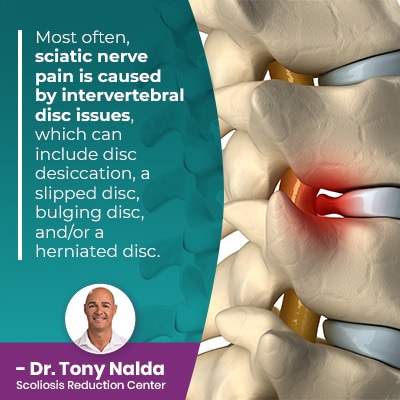What Causes Sciatica To Flare-Up? Treatment & Prevention Tips

Sciatica has different causes, and in order to be treated effectively, its underlying cause has to be determined and shape the design of treatment plans. If the sciatic nerve is exposed to uneven pressure, it can become pinched, compressed, and/or impinged, which can cause discomfort felt anywhere along the sciatic nerve's pathway.
When it comes to sciatica, it's not a condition itself; it's referencing the symptom of sciatic nerve pain, which is commonly caused by the sciatic nerve being pinched. Flare ups are triggered by the symptom's underlying cause, the most common of which is intervertebral disc deterioration.
Sciatic nerve pain can range in frequency and intensity, so let's start by exploring the nature of sciatic nerve pain and its most-common causes.
Table of Contents
Defining Sciatica: Condition or Symptom?
While most people consider sciatica to be a condition, it's more accurately considered a symptom because sciatic nerve pain can have different causes.
The sciatic nerve is the longest and largest nerve in the body, and as a mixed nerve, it contains both motor and sensory fibers, which is why the sciatic nerve being pinched can cause symptoms related to both sensation and movement.
The sciatic nerve starts in the lumbar spine (lower back) and extends down the buttock, back of the leg and into the foot.
In most cases, sciatic nerve pain is felt on the life side of the body, but in some cases, it can involve the right side, and in rare cases, it can affect both.
So if the sciatic nerve is exposed to uneven forces, its effects can be felt anywhere along the sciatic nerve's extensive pathway.
When a person is experiencing sciatic nerve pain, it's important to understand the difference between solely treating sciatica as a symptom, or addressing the underlying condition/issue causing the uneven forces that are affecting the sciatic nerve.
Modern medicine can include quick fixes with prescription medications, which can help patients with pain management, but as it's only addressing pain as a symptom, rather than addressing its underlying cause, it's only going to provide short-term pain relief.
If the underlying cause of the sciatic nerve pain is determined and addressed proactively with treatment, as the cause of the pain is targeted, with treatment success, pain will be reduced/eliminated as a symptom.
Spinal Anatomy and Sciatic Nerve Pain
In order to better understand the nature of spinal nerves and nerve compression, let's explore some basic spinal anatomy.
There are three main sections of the spine: cervical spine (neck), thoracic spine (middle/upper back), and lumbar spine (lower back).
There are 31 pairs of spinal nerves that exit the spinal cord to branch off in different directions throughout the body.
The nerves of the cervical spine affect function of the neck, shoulders, and head, while nerves of the lumbar spine will affect lower-body movement, sensation, and bladder/bowel function.
There are five pairs of lumbar nerves, and as mentioned, the sciatic nerve starts in the lumbar spine and extends down the buttock, back of the leg, and into the foot; in most cases, sciatic nerve pain is felt down the left side of the lower body.
The spine consists of bones called vertebrae that are stacked on top of one another in a straight/neutral alignment, and maintaining the spine's natural alignment and curves means preserving its overall health, strength, and function.
The spine's natural and healthy curves make it stronger, more flexible, and better able to distribute mechanical stress during activity so no one section of the spine is more strained than the others.
Between adjacent vertebrae sits an intervertebral disc, and these discs play many roles that are key to spinal health; they give the spine structure (adjacent vertebrae attach to the disc in between), flexibility, provide cushioning so friction isn't generated with movement, and act as the spine's shock absorbers.
The spinal discs are generally the first spinal structures to show, and feel, the effects of spinal degeneration, which can be natural and age-related, or involve a condition/issue that causes excessive rates of deterioration/degeneration of the spine.
So now let's talk about sciatica flare ups: what causes sciatica to flare up, and how to minimize flare ups.
Sciatica Flare Ups
As the sciatic nerve runs from the lumbar spine and down the back of the lower body, these are where direct effects of sciatic nerve compression are going to be felt.
 Sciatica can involve mild and intermittent flare ups or chronic and debilitating pain involving consistent and severe flare ups.
Sciatica can involve mild and intermittent flare ups or chronic and debilitating pain involving consistent and severe flare ups.
Sciatica pain tends to be worse at night, when sitting for long periods, or when standing up from a seated position, and this is due to pressure on the lower back.
Many cases of sciatic nerve pain resolve themselves in a matter of weeks, but persistent flare ups that continue and increase in intensity will require proactive treatment that addresses its underlying cause.
Sciatica pain can vary from person to person, particularly with different patient ages, causes, and severity levels, but common symptoms of sciatic nerve compression can include:
- Pain in the lower back
- Pain in the buttock
- Pain felt down the back of a leg
- Numbness felt in the lower back
- Numbness in the buttock
- Numbness in the leg and/or foot
- Loss of movement in the lower body
- Pain that increases with movement
- Sensations of pins and needles in the legs, toes, or feet
- Electric-like shooting pains
- Muscle weakness
- Impaired bowel and/or bladder function (related to cauda equina syndrome)
So in order to minimize the frequency of a sciatica flare up, effective treatment is needed, but first, the cause has to be determined.
Common Sciatica Causes
As is the case with a number of spinal issues, there are often multiple causes, and sciatica is no exception.
 Most often, sciatic nerve pain is caused by intervertebral disc issues, which can include disc desiccation, a slipped disc, bulging disc, and/or a herniated disc.
Most often, sciatic nerve pain is caused by intervertebral disc issues, which can include disc desiccation, a slipped disc, bulging disc, and/or a herniated disc.
Intervertebral Disc Issues
When we're born, the discs are made of approximately 80 percent water, but as we age, those fluid levels decrease, and disc desiccation is a common indicator of degenerative disc disease.
When a disc becomes a slipped (bulging) disc, this means its inner nucleus is pushing against its outer annulus, causing it to bulge outwards.
A herniated disc occurs if its inner nucleus pushes through a tear in its outer annulus.
When a disc starts to deteriorate, it changes shape, which affects the position of adjacent vertebrae, and with bulging and/or herniated discs, the disc's change in shape makes it encroach on space within the spine: space that's used by the spinal nerves.
If the sciatic nerve has lost space, it can become compressed, irritated, and/or impinged (pinched).
If a disc in the lumbar spine has deteriorated, it can directly impact the nerve roots of the lumbar spine, including the sciatic nerve.
In addition, underlying causes of sciatica pain can include the presence of a spinal condition such as scoliosis, bone spurs, and/or spinal stenosis.
Scoliosis
Scoliosis is the development of an unnatural sideways spinal curve, with rotation, and while scoliosis can develop in any spinal section, if it develops in the lumbar spine, the condition's uneven forces expose the spine, and its surrounding muscles and nerves, to uneven pressure.
While not everyone with lumbar scoliosis is guaranteed to develop sciatica, it is a common complication.
Bone Spurs
Bone spurs are bony projections that grow on the edges of bones and/or where joints meet.
Bone spurs that grow on the lumbar vertebrae can press against the sciatic nerve root and cause a sciatica flare up.
Lumbar Spinal Stenosis
Lumbar spinal stenosis is the narrowing of the space within the spine, causing the nerves in the affected area to become squeezed and irritated.
The narrowing of the spinal canal within the lumbar spine can leave less room than is needed for the sciatic nerve to function within optimally.
Conclusion
So what causes sciatica to flare up is its underlying cause, and the only way to effectively treat sciatic nerve pain is by determining and addressing its underlying cause.
If sciatica doesn't resolve on its own and is left untreated, this is likely to increase the frequency and intensity of flare ups.
The sciatic nerve is a large and complex mixed nerve, containing both sensory and motor fibers, which is why the sciatic nerve being compressed can cause symptoms involving strange sensations and motion issues.
As is the case with most spinal conditions/issues, the major effects of sciatica are going to be felt in the area of the body closest to the affect nerve/spinal section, so as the sciatic nerve starts in the lumbar spine, it's the lower body that will feel the direct effects of sciatic nerve compression.
Here at the Scoliosis Reduction Center, I have experience addressing sciatica pain and providing pain relief through proactively determining its underlying cause and customizing treatment plans around it for long-term sustainable treatment results.
If the cause is related to degenerative disc disease and/or intervertebral disc issues, treatment has to focus on improving disc health and function and preventing further damage.
If the cause is determined to be the presence of an underlying spinal condition, the spinal condition itself is going to be treated because this alone has the potential to reduce/eliminate sciatic nerve pain as a symptom.
Dr. Tony Nalda
DOCTOR OF CHIROPRACTIC
After receiving an undergraduate degree in psychology and his Doctorate of Chiropractic from Life University, Dr. Nalda settled in Celebration, Florida and proceeded to build one of Central Florida’s most successful chiropractic clinics.
His experience with patients suffering from scoliosis, and the confusion and frustration they faced, led him to seek a specialty in scoliosis care. In 2006 he completed his Intensive Care Certification from CLEAR Institute, a leading scoliosis educational and certification center.
About Dr. Tony Nalda
 Ready to explore scoliosis treatment? Contact Us Now
Ready to explore scoliosis treatment? Contact Us Now





